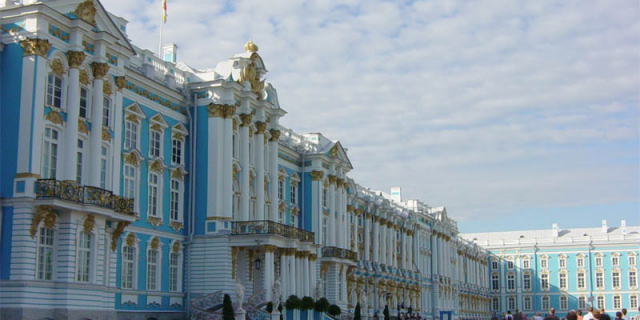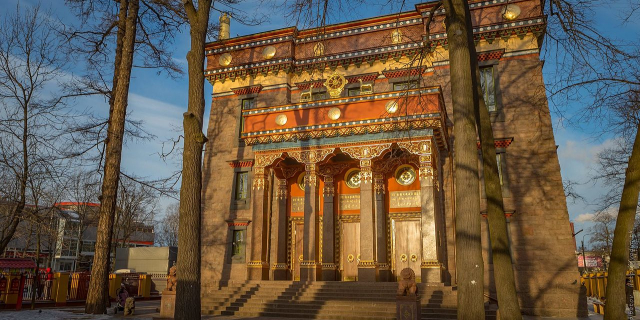Янтарная комната
( Amber Room )
The Amber Room (Russian: Янтарная комната, tr. Yantarnaya Komnata, German: Bernsteinzimmer) was a chamber decorated in amber panels backed with gold leaf and mirrors, located in the Catherine Palace of Tsarskoye Selo near Saint Petersburg.
Constructed in the 18th century in Prussia, the room was dismantled and eventually disappeared during World War II. Before its loss, it was considered an "Eighth Wonder of the World". A reconstruction was made, starting in 1979 and completed and installed in the Catherine Palace in 2003.
The Amber Room was intended in 1701 for the Charlottenburg Palace, in Berlin, Prussia, but was eventually installed at the Berlin City Palace. It was designed by German baroque sculptor Andreas Schlüter and Danish amber craftsman Gottfried Wolfram. Schlü...Read more
The Amber Room (Russian: Янтарная комната, tr. Yantarnaya Komnata, German: Bernsteinzimmer) was a chamber decorated in amber panels backed with gold leaf and mirrors, located in the Catherine Palace of Tsarskoye Selo near Saint Petersburg.
Constructed in the 18th century in Prussia, the room was dismantled and eventually disappeared during World War II. Before its loss, it was considered an "Eighth Wonder of the World". A reconstruction was made, starting in 1979 and completed and installed in the Catherine Palace in 2003.
The Amber Room was intended in 1701 for the Charlottenburg Palace, in Berlin, Prussia, but was eventually installed at the Berlin City Palace. It was designed by German baroque sculptor Andreas Schlüter and Danish amber craftsman Gottfried Wolfram. Schlüter and Wolfram worked on the room until 1707, when work was continued by amber masters Gottfried Turau and Ernst Schacht from Danzig (Gdańsk).
It remained in Berlin until 1716, when it was given by the Prussian King Frederick William I to his ally Tsar Peter the Great of the Russian Empire. In Russia, the room was installed in the Catherine Palace. After expansion and several renovations, it covered more than 55 square metres (590 sq ft) and contained over 6 tonnes (13,000 lb) of amber.
The Amber Room was looted during World War II by the Army Group North of Nazi Germany, and taken to Königsberg for reconstruction and display. Some time in early 1944, with Allied forces closing in on Germany, the room was disassembled and crated for storage in the Castle basement. Königsberg was destroyed by allied bombers in August 1944 and documentation of the room location ends there. Its eventual fate and current whereabouts, if it survives, remain a mystery. In 1979, the decision was taken to create a reconstructed Amber Room at the Catherine Palace in Pushkin. After decades of work by Russian craftsmen and donations from Germany, it was completed and inaugurated in 2003.
 Corner section of the reconstructed Amber Room
Corner section of the reconstructed Amber RoomThe Amber Room was begun in 1701 with the purpose of being installed at Charlottenburg Palace, the residence of Frederick, the first King in Prussia, at the urging of his second wife, Sophia Charlotte.[1][2] The concept and design of the room was drafted by Andreas Schlüter.[1][2] It was fabricated by Gottfried Wolfram, master craftsman to the Danish court of King Frederick IV of Denmark, with help from the amber masters Ernst Schacht and Gottfried Turau from Danzig, now Gdańsk in Poland.[1][2][3]
Although originally intended for installation at Charlottenburg Palace, the complete panels were eventually installed at Berlin City Palace.[4] The Amber Room did not, however, remain at Berlin City Palace for long. Peter the Great of Russia admired it during a visit, and in 1716, King Frederick I's son Frederick William I presented the room to Peter as a gift, which forged a Russo-Prussian alliance against Sweden.[2][3]
The original Berlin design of the Amber Room was reworked in Russia in a joint effort by German and Russian craftsmen.[1][2] It was Peter's daughter Empress Elizabeth who decided the amber treasure should be installed at Catherine Palace, where the Russian Imperial family typically spent their summers.[3][5] After several other 18th-century renovations, the room covered more than 55 square metres (590 sq ft) and contained over 6 tonnes (13,000 lb) of amber.[2] The room took over ten years to construct.[1][2]
Theft during World War II An angel statue featured on the wall of the Amber Room
An angel statue featured on the wall of the Amber RoomShortly after the beginning of the German invasion of the Soviet Union in World War II, the curators responsible for removing the art treasures in Leningrad tried to disassemble and remove the Amber Room.[1] However, over the years the amber had dried out and become brittle, making it impossible to move the room without the amber crumbling.[1] The Amber Room was therefore hidden behind mundane wallpaper, in an attempt to keep German forces from seizing it, but the attempt to hide such a well-known piece of art failed.[3]
German soldiers of Army Group North disassembled the Amber Room within 36 hours under the supervision of two experts.[2][3][5][6] On 14 October 1941, the priceless room reached Königsberg in East Prussia, for storage and display in the town's castle.[2][3][6] On 13 November 1941, a Königsberg newspaper announced an exhibition of the Amber Room at Königsberg Castle.[6]
Last days in KönigsbergOrders given by Hitler on 21 and 24 January 1945 ordered the movement of looted possessions from Königsberg.[7] This allowed Albert Speer, Reichsminister of Armaments, and his administration team to transport cultural goods of priority.[7] However, before the Amber Room could be moved, Erich Koch, who was in charge of civil administration in Königsberg during the final months of the war, abandoned his post and fled from the city, leaving General Otto Lasch in command.[8]
In August 1944, Königsberg was heavily fire-bombed by the Royal Air Force. It suffered further extensive damage from the artillery of the advancing Red Army before the final occupation on 9 April 1945.[9]
































Add new comment